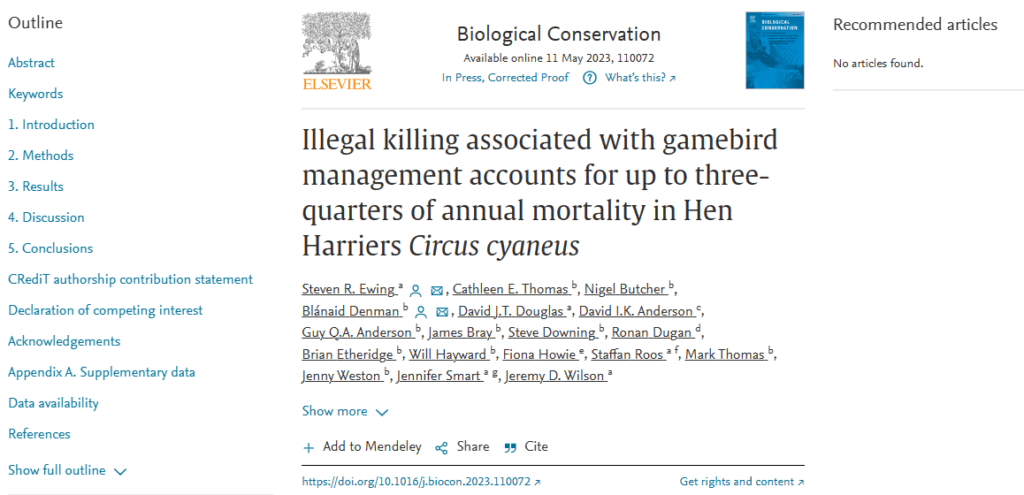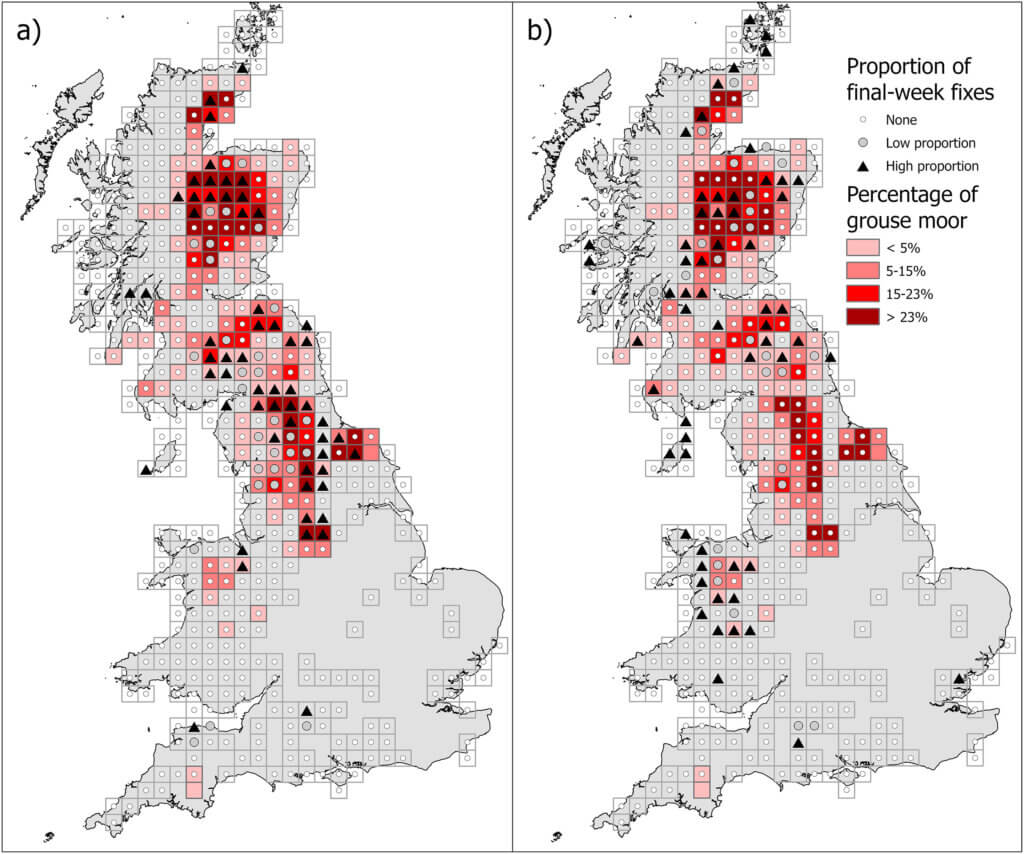
This paper, published today, is a re-run of the previous publication of Natural England’s similar dataset back in 2019 – if you understood the previous paper then this new one won’t alter your understanding (click here for what is actually a much-praised explanation of the previous, excellent, but highly technical, paper).
I don’t use ‘re-run’ in a disparaging way – this paper adds to but largely confirms the previous study’s findings. The advantages of this paper are that:
- the data are more up to date, including birds tagged in 2020 (whereas the 2019 paper included results from birds tagged up to and including 2017)
- the sample size is much bigger – 148 v 58 birds
- the locations in which Hen Harriers were tagged were much wider – more of Scotland, Wales, Isle of Man
Here again we see that survival of Hen Harriers is ridiculously low, and that a major part of that is because of illegal killing.
Here’s a very good image: look first at the red-pink-white colouration – that shows how much grouse moor there is in an area. Grouse moors are mostly found in northern England, a few bits of NE Wales, and parts of largely eastern Scotland above and below the Glasgow-Edinburgh line.

Now compare where Hen Harriers died/ceased transmitting – the black triangles in particular – and compare the right hand map (deaths from natural causes) with the left hand map (illegal persecution). What do you see? You see that deaths from illegal persecution are closely grouped around grouse moors – there are a few cases off grouse moors, and a very few miles away from any grouse moors, but most are associated with grouse moor management. In contrast, the right hand map (personally, I think they should have had the maps the other way around) shows Hen Harriers dying of natural causes all over the place. There is even a dearth of natural deaths on the grouse moors of the north of England.
What you are seeing in these maps is summed up in this paragraph:
The proportion of final-week fixes of birds killed illegally increased with the proportion of grouse moor in the landscape (Table 2b, Fig. S2a & b). Males were almost six times and females three times more likely to be illegally killed in 20 km squares where grouse moors were a dominant (≥50 %) land use compared to squares not managed for grouse (females: emm0 = 0.018, 95 % CI: 0.012–0.025; emm0.5 = 0.055, 95 % CI: 0.032–0.092; males: emm0 = 0.007, 95 % CI: 0.004–0.012; emm0.5 = 0.039, 95 % CI: 0.020–0.075). Areas with high levels of illegal killing included the Pennines in northern England, and in and around the Cairngorms National Park in northeast Scotland (Figs. 6, S3a & b). The proportion of final-week fixes of birds dying naturally was not related to the proportion of grouse moor in the landscape in either sex (Fig. S2a & b). Significant differences in the relationship between grouse moor management and harriers dying naturally and illegally were only found in males (males: est. = 5.30, s.e. = 1.28 p < 0.001; females: est. = 1.81, s.e. = 1.04, p = 0.300).
This study also shows, as did the previous NE data, that the more time you spend on land managed for grouse shooting, the higher your chance of being killed illegally, thus ‘a 10 % increase in grouse moor use resulted in a 43 % increase in mortality risk’.
This large-scale and thorough study is further evidence, as if any were needed, not only that grouse moor management is a rich source of criminality but also that decision makers and political representatives across the UK have been slow to act on the science. In Scotland, the pace has been snail-like, in England the pace has been that of a dead snail. A Conservative government will never act with vigour on this issue – the perpetrators are their mates.
A good study which tells a damning story. On a personal note, nice to see so many names of former colleagues in the list of authors. For example, Nigel Butcher has been doing ‘tech stuff’ for RSPB for a great many years and is the type of gifted backroom guy, akin to Q in Bond films, on which others have to rely.
[registration_form]
Confirmation if indeed that was needed of the awful criminality shown by the previous NE paper with a bigger and more widespread data set. There should be “no hiding place” for the grousers, their support organisations or their apologists they are exposed for all to see as rife with criminality and criminals in their midst, something some of us always knew. Their vehement denials coupled with their claimed intolerance of raptor persecution is totally exposed a s a face saving sham. they should be ashamed but probably won’t be due to a blinkered conviction they are right, it isn’t true ( it is afterall from RSPB employers of the hated investigations team- incidentally doing a job the statutory authorities should be funding and doing) and there are amongst them those who think they can still bluff it out. Perhaps they could survive if they had been really committed to getting rid of and/or shopping the criminals in their midst, as they MUST know who they are. Yet not one piece of evidence has been forthcoming from the so called raptor persecution intolerants, they are put simply exposed as liars by this science. Remember the breeding performance of Peregrines and in Scotland Eagles on grouse moors is at least as bad as well. Time their sport was gone, perhaps under a better government it will be.
It seems to me that this clear picture must be publicised in as many ways as possible. There are many people who have a mild interest in nature (and a vote!) who may have seen a news article but they are not yet aware of the depth and persistence of the problem.
Let us all spread the message – grouse shooting has strong links to the illegal killing of raptors.